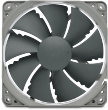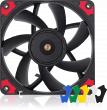Noctua NF-A9 FLX 12V 1600RPM 92mm Premium Quality Fan
Noctua’s new 92mm fans have been updated to feature their innovative technology. The NF-A9 FLX is their best performing standard 3-pin fan that is supplied with two low noise resistors.
Features
- Sound-optimised blade geometry and profile (Flow Acceleration Channels)
- Self-stabilising oil-pressure bearing (SSO2 Bearing)
- <9 dB(A) minimum noise with supplied U.L.N.A.
- 38.0 CFM maximum airflow
- Includes 4 Vibration-Compensators
- Six years warranty
The NF-A9 is a highly optimised, premium quality quiet 92mm fan. Featuring Noctua’s AAO (Advanced Acoustic Optimisation) frame as well as sophisticated aerodynamic design measures such as Flow Acceleration Channels, the NF-A9 further improves the renowned quiet cooling performance of the award-winning NF-B9. The FLX version provides 1600/1250/1050rpm speed settings via the supplied Low-Noise Adaptors in order to provide full flexibility in fine-tuning the fan for maximum ventilation performance or near-silent operation. Its superb running smoothness, reference-class SSO2 bearing and Noctua’s trusted premium quality make it an elite choice for the highest demands.
| Specifications | NF-A9 FLX |
|---|---|
| Size | 92x92x25 mm |
| Connector | 3-pin |
| Bearing | SSO2-Bearing |
| Blade Geometry | A-Series with Flow Acceleration Channels |
| Rotational Speed (±10%) | 1600 RPM |
| Rotational Speed with L.N.A. (±10%) | 1250 RPM |
| Rotational Speed with U.L.N.A. (±10%) | 1050 RPM |
| Airflow | 38.0 CFM |
| Airflow with L.N.A. | 30.1 CFM |
| Airflow with U.L.N.A. | 25.2 CFM |
| Acoustical Noise | 17.1 dB(A) |
| Acoustical Noise with L.N.A. | 11.6 dB(A) |
| Acoustical Noise with U.L.N.A. | 8.4 dB(A) |
| Static Pressure | 1.96 mm H2O |
| Static Pressure with L.N.A. | 1.40 mm H2O |
| Static Pressure with U.L.N.A. | 0.74 mm H2O |
| Input Power | 0.84 W |
| Input Current | 0.07 A |
| Voltage | 12 V |
| Accessories | Low-Noise Adaptor (L.N.A.), Ultra-Low-Noise Adaptor (U.L.N.A.), 3:4-Pin Adaptor, |
| Warranty | 24 months |
| EAN barcode | 4716123315506 |
| Specifications | NF-A9 FLX |
|---|---|
| Size | 92x92x25 mm |
| Connector | 3-pin |
| Bearing | SSO2-Bearing |
| Blade Geometry | A-Series with Flow Acceleration Channels |
| Rotational Speed (±10%) | 1600 RPM |
| Rotational Speed with L.N.A. (±10%) | 1250 RPM |
| Rotational Speed with U.L.N.A. (±10%) | 1050 RPM |
| Airflow | 38.0 CFM |
| Airflow with L.N.A. | 30.1 CFM |
| Airflow with U.L.N.A. | 25.2 CFM |
| Acoustical Noise | 17.1 dB(A) |
| Acoustical Noise with L.N.A. | 11.6 dB(A) |
| Acoustical Noise with U.L.N.A. | 8.4 dB(A) |
| Static Pressure | 1.96 mm H2O |
| Static Pressure with L.N.A. | 1.40 mm H2O |
| Static Pressure with U.L.N.A. | 0.74 mm H2O |
| Input Power | 0.84 W |
| Input Current | 0.07 A |
| Voltage | 12 V |
| Accessories | Low-Noise Adaptor (L.N.A.), Ultra-Low-Noise Adaptor (U.L.N.A.), 3:4-Pin Adaptor, |
| Warranty | 24 months |
| EAN barcode | 4716123315506 |
Customer Reviews
These fans are excellent and silent. I am using them in an Audio/Video cabinet so it is important that the fans are quiet. My only criticism is the use of the cables to setup the fans at lower speeds. There is no information how they work I had assumed it was related to vibration reduction not speed. The cables are very effective by reducing the voltage to the fans so reducing the speed.
Alienware Aurora PSU Fixed
My 2010 Alienware Aurora R1 was beginning to sound like a Hoover. Replaced all fans with Noctua units using this one in the PSU. BIG difference! Wouldn’t know it was switched on now.
Quality system fan
I bought this fan to replace my system fan along with a new CPU fan, after the initial upgrade I found both worked perfectly well, the system fan was working in conjunction with the CPU PWM fan, as the CPU fan speeds up so too does the system fan, even though the system fan isn’t PWM, I cannot fault this fan or the other, excellent product’s providing whisper quiet operation, I will never use any other, they are not a marketing gimmick, they really are that good.
Product Resources
FAQ
How do I measure fan size?
The size of fan you need will generally be determined by the size of the fan fitting position in your PC case. The sizes of all the fans on our website are shown as measured along any one of the fan’s four sides, NOT the distance between the fan’s screw holes! Our most popular fan size is 120mm, followed by 80mm. This isn’t really dictated by customer preference, but more by recent designs of PC cases.
As for the thickness (depth) of the fan, generally 25mm (1 inch) is by far the most common depth, although smaller fans can have shallower depths such as 15mm or even 10mm. All our fans are 25mm thick unless otherwise stated. If you have any questions about which fan you should order, please don’t hesitate to get in touch.
If you know the distance between the fan mounting screw holes but don’t know what fan size to order, please see the following table. Note that the mounting hole measurements shown below are taken horizontally or vertically between the holes and not diagonally.
Screw hole spacings and fan sizes
Space Between Screw Holes Fan Size 32mm 40mm 40mm 50mm 50mm 60mm 60mm 70mm 72mm 80mm 83mm 92mm 105mm 120mm I received a small cable (resistor) with my fan; what is it for?
The resistor cable (also called Ultra Low Noise or ULN cable) is designed to allow the fan to run slightly slower for even quieter operation. The benefit in lower running noise is significant. Although the airflow will be reduced slightly, this usually has minimal effect on PC temperature. We would generally recommend using the ULN resistor cable for best results in almost all circumstances.
How can I tell which way the air blows through the fan?
Hold the fan so that the round fan sticker is facing you. You are looking at the rear of the fan. When you plug the fan in, the air will be blowing towards you. If you want a fan to act as an air intake, then the fan sticker will be facing the inside of the case. Some fans also have two small arrows moulded into their plastic housing - one arrow shows the direction of airflow, and the other (at 90°) shows the direction of blade rotation.
Is it possible to use a 4-pin PWM fan or CPU cooler with a motherboard which has only 3-pin fan headers on it?
Electrically, there is no problem doing this - the fourth pin on the fan cable is used purely for PWM control and is not needed in order for the fan to run. So you can plug the 4-pin fan connector onto the 3-pin motherboard fan header, leaving the fourth pin not connected to anything. The fan will potentially run at full speed, so if you would like to reduce the speed of the fan you will need to adjust the fan speed setting in your BIOS or use fan control software such as SpeedFan in Windows.
The only other problem to consider is that occasionally, components immediately adjacent to the motherboard fan header can get in the way of the larger 4-pin fan connector, physically preventing connection. This problem also occurs if you try to use an in-line fan speed controller such as the one made by Gelid.
Another avenue to explore is the possibility of using a bay-mounted fan controller. Several models are available now which provide 4-pin fan headers, so this is an easy way to use 4-pin PWM fans in a PC system which has only 3-pin fan headers on its motherboards. When using this method, you may find it necessary to disable any fan warning settings in your motherboard BIOS, since the motherboard may incorrectly believe that its CPU fan has failed when the fan is connected to a fan controller rather than directly to the motherboard itself.
Top Quiet Fans

Noctua NF-A12x25 PWM chromax.black.swap 12V 2000RPM 120mm Fan

Noctua NF-P12 REDUX PWM 12V 1700RPM 120mm Quiet Case Fan

Noctua NF-S12B REDUX 12V 700RPM 120mm Quiet Case Fan

Noctua NF-F12 iPPC PWM 12V 2000RPM 120mm High Performance Fan

Noctua NF-F12 iPPC PWM 12V 3000RPM 120mm High Performance Fan

Noctua NF-A12x25 PWM 12V 2000RPM 120mm Ultimate Quality Quiet Fan

Noctua NF-A14 PWM chromax.black.swap 12V 1500RPM 140mm Fan

Noctua NF-A12x15 PWM chromax.black.swap 12V 1850RPM 120x15mm Fan

Noctua NF-A14 PWM 12V 1500RPM 140mm Premium Quality Fan

Noctua NF-A6x25 PWM 12V 3000RPM 60x25mm Low Noise Fan



